key Citroen C4 DAG 2014.5 2.G Owner's Guide
[x] Cancel search | Manufacturer: CITROEN, Model Year: 2014.5, Model line: C4 DAG, Model: Citroen C4 DAG 2014.5 2.GPages: 340, PDF Size: 12.89 MB
Page 158 of 340
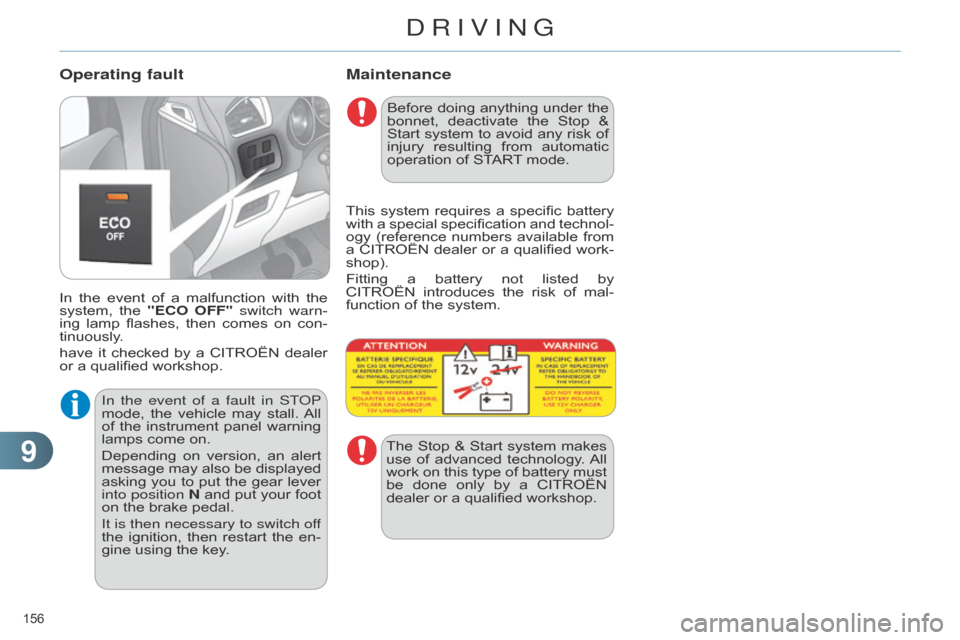
99
156ô
C4-2_en_Chap09_conduite_ed01-2014
Maintenance
Inô theô event ô of ô a ô malfunction ô with ô the ô system,
ô the ô "ECO OFF" switch warn-
ing
ô
lamp
ô
flashes,
ô
then
ô
comes
ô
on
ô
con
-
tinuously.
have
ô
it
ô
checked
ô
by
ô
a
ô
CITROûN
ô
dealer
ô
or
ô a ô qualified ô workshop.
Operating fault
Beforeô doingô anything ô under ô the ô bonnet,
ô deactivate ô the ô Stop ô & ô
Start
ô
system
ô
to
ô
avoid
ô
any
ô
risk
ô
of
ô
injury
ô
resulting
ô
from
ô
automatic
ô
operation
ô of ô START
ô
mode.
This
ô
system
ô
requires
ô
a
ô
specific
ô
battery
ô
with
ô
a
ô
special
ô
specification
ô
and
ô
technol
-
ogy
ô
(reference
ô
numbers
ô
available
ô
from
ô
a
ô
CITROûN
ô
dealer
ô
or
ô
a
ô
qualified
ô
work
-
shop).
Fitting
ô
a
ô
battery
ô
not
ô
listed
ô
by
ô
CITROûNô
introduces ô
the
ô
risk
ô
of
ô
mal
-
function
ô of ô the ô system.
The
ô
Stop
ô
&
ô
Start
ô
system
ô
makes
ô
use
ô
of
ô
advanced
ô
technology
. ô
All
ô
work
ô
on
ô
this
ô
type
ô
of
ô
battery
ô
must
ô
be
ô
done
ô
only
ô
by
ô
a
ô
CITROûN
ô
dealer
ô or ô a ô qualified ô workshop.
In the event of a fault in ST
o
P
mode,
ô
the
ô
vehicle
ô
may
ô
stall.
ô
All
ô
of
ô
the
ô
instrument
ô
panel
ô
warning
ô
lamps
ô
come
ô
on.
Depending
ô
on
ô
version,
ô
an
ô
alert
ô
message
ô
may
ô
also
ô
be
ô
displayed
ô
asking
ô
you
ô
to
ô
put
ô
the
ô
gear
ô
lever
ô
into position
N
ô
and
ô
put
ô
your
ô
foot
ô
on
ô
the
ô
brake
ô
pedal.
It is then necessary to switch off
the
ô
ignition,
ô
then
ô
restart
ô
the
ô
en
-
gine
ô
using
ô
the
ô
key.
DRIVING
Page 173 of 340
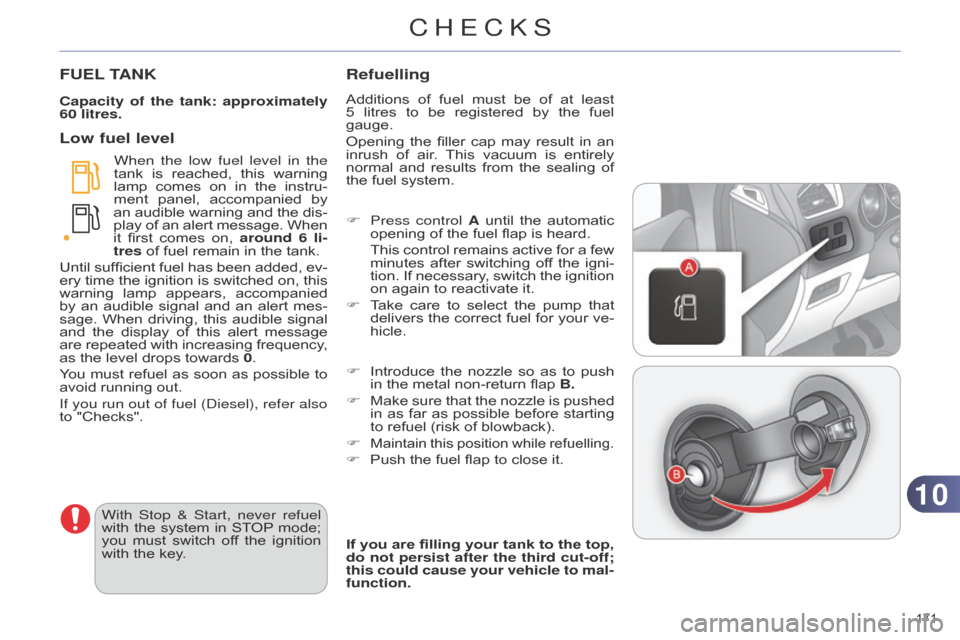
1010
171ô
C4-2_en_Chap10_verification_ed01-2014
FUEL TANK
Capacity of the tank: approximately
60 litres.
When the low fuel level in the
tank
ô
is
ô
reached,
ô
this
ô
warning
ô
lamp
ô
comes
ô
on
ô
in
ô
the
ô
instru
-
ment
ô
panel,
ô
accompanied
ô
by
ô
an
ô
audible
ô
warning
ô
and
ô
the
ô
dis
-
play
ô
of
ô
an
ô
alert
ô
message.
ô
When
ô
it
ô
first
ô
comes
ô
on,
ô
around
6 li-
tres
ô of ô fuel ô remain ô in ô the ô tank.
Until
ô
sufficient
ô
fuel
ô
has
ô
been
ô
added,
ô
ev
-
ery
ô
time
ô
the
ô
ignition
ô
is
ô
switched
ô
on,
ô
this
ô
warning
ô
lamp
ô
appears,
ô
accompanied
ô
by
ô
an
ô
audible
ô
signal
ô
and
ô
an
ô
alert
ô
mes
-
sage.
ô
When
ô
driving,
ô
this
ô
audible
ô
signal
ô
and
ô
the
ô
display
ô
of
ô
this
ô
alert
ô
message
ô
are
ô
repeated
ô
with
ô
increasing
ô
frequency
, ô
as
ô the ô level ô drops ô towards ô 0.
You
ô
must
ô
refuel
ô
as
ô
soon
ô
as
ô
possible
ô
to
ô
avoid
ô running ô out.
If you run out of fuel (
d iesel), refer also
to
ô "Checks".
Low fuel level Refuelling
Additionsô of
ô fuel ô must ô be ô of ô at ô least ô
5ô litres ô to ô be ô registered ô by ô the ô fuel ô
gauge.
Opening
ô
the
ô
filler
ô
cap
ô
may
ô
result
ô
in
ô
an
ô
inrush
ô
of
ô
air
. ô
This
ô
vacuum
ô
is
ô
entirely
ô
normal
ô
and
ô
results
ô
from
ô
the
ô
sealing
ô
of
ô
the
ô fuel ô system.
F
Press control
A ô
until
ô
the
ô
automatic
ô
opening
ô of ô the ô fuel ô flap ô is ô heard.
ô This
ô
control
ô
remains
ô
active
ô
for
ô
a
ô
few
ô
minutes
ô
after
ô
switching
ô
of
f ô
the
ô
igni
-
tion.
ô
If
ô
necessary
, ô
switch
ô
the
ô
ignition
ô
on
ô again ô to ô reactivate ô it.
F
ô
T
ake ô
care
ô
to
ô
select
ô
the
ô
pump
ô
that
ô
delivers
ô
the
ô
correct
ô
fuel
ô
for
ô
your
ô
ve
-
hicle.
If you are filling your tank to the top,
do not persist after the third cut-off;
this could cause your vehicle to mal-
function.
With Stop & Start, never refuel
with
ô
the
ô
system
ô
in
ô
ST
OP
ô mode;
ô
you
ô
must
ô
switch
ô
of
f
ô
the
ô
ignition
ô
with
ô
the
ô
key. F
ô
Introduce
ô
the
ô
nozzle
ô
so
ô
as
ô
to
ô
push
ô
in
ô the ô metal ô non-return ô flap ô B.
F
ô
Make
ô
sure
ô
that
ô
the
ô
nozzle
ô
is
ô
pushed
ô
in
ô
as
ô
far
ô
as
ô
possible
ô
before
ô
starting
ô
to
ô refuel ô (risk ô of ô blowback).
F
Maintainô this ô position ô while ô refuelling.
Fô Pushô the ô fuel ô flap ô to ô close ô it.
CHECKS
Page 190 of 340
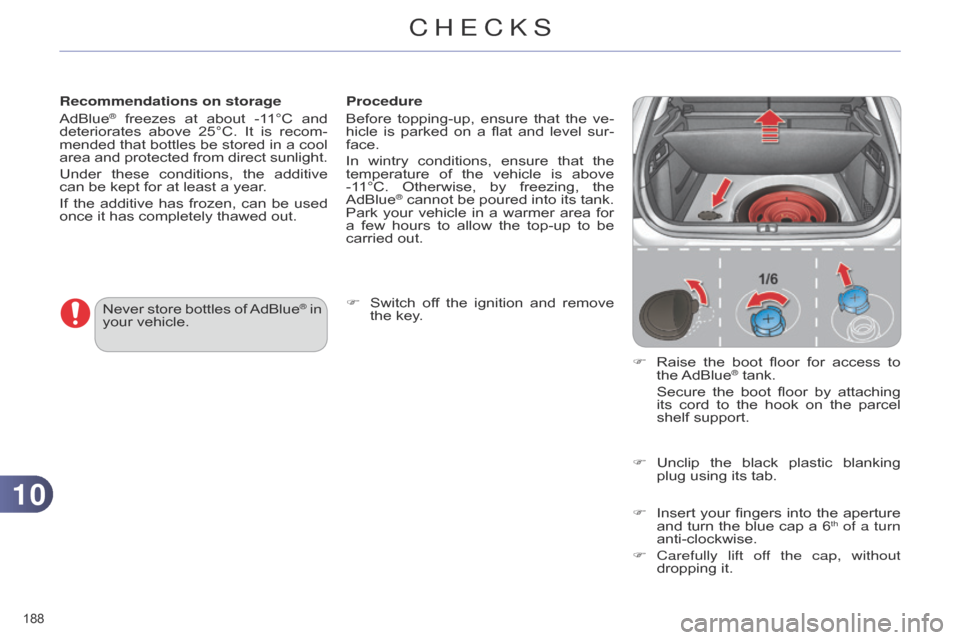
1010
188ô
C4-2_en_Chap10_verification_ed01-2014
Recommendations on storage
AdBlueôÛô freezesô at ô about ô -1 1ô¯C ô and ô deteriorates
ô above ô 25ô¯C. ô It ô is ô recom -
mended
ô
that
ô
bottles
ô
be
ô
stored
ô
in
ô
a
ô
cool
ô
area
ô
and
ô
protected
ô
from
ô
direct
ô
sunlight.
Under
ô
these
ô
conditions,
ô
the
ô
additive
ô
can
ô
be
ô
kept ô for ô at ô least ô a ô year.
If
ô
the
ô
additive
ô
has
ô
frozen,
ô
can
ô
be
ô
used
ô
once
ô
it
ô
has ô completely ô thawed ô out.
Never
ô
store
ô
bottles
ô
of
ô
AdBlueôÛ in
your
ô
vehicle. Procedure
Before
ô
topping-up,
ô
ensure
ô
that
ô
the
ô
ve
-
hicle ô
is
ô
parked
ô
on
ô
a
ô
flat
ô
and
ô
level
ô
sur
-
face.
In ô
wintry
ô
conditions,
ô
ensure
ô
that
ô
the
ô
temperature
ô
of
ô
the
ô
vehicle
ô
is
ô
above
ô
-1
1ô¯C. ô
Otherwise,
ô
by
ô
freezing,
ô
the
ô
AdBlueôÛô cannot
ô be ô poured ô into ô its ô tank. ô Park
ô your ô vehicle ô in ô a ô warmer ô area ô for ô
a
ô
few
ô
hours
ô
to
ô
allow
ô
the
ô
top-up
ô
to
ô
be
ô
carried
ô
out.
F
ô
Switch
ô
of
f ô
the
ô
ignition
ô
and
ô
remove
ô
the
ô
key. F
ô
Raise
ô
the
ô
boot
ô
floor
ô
for
ô
access
ô
to
ô
the
ô
AdBlueôÛô tank.
ô Secure
ô
the
ô
boot
ô
floor
ô
by
ô
attaching
ô
its
ô
cord
ô
to
ô
the
ô
hook
ô
on
ô
the
ô
parcel
ô
shelf
ô
support.
F
ô
Unclip
ô
the
ô
black
ô
plastic
ô
blanking
ô
plug
ô
using
ô
its ô tab.
F
ô
Insert
ô
your
ô
fingers
ô
into
ô
the
ô
aperture
ô
and
ô
turn
ô
the
ô
blue
ô
cap
ô
a
ô
6th of a turn
anti-clockwise.
F
Carefully
lift off the cap, without
dropping
ô
it.
CHECKS
Page 191 of 340
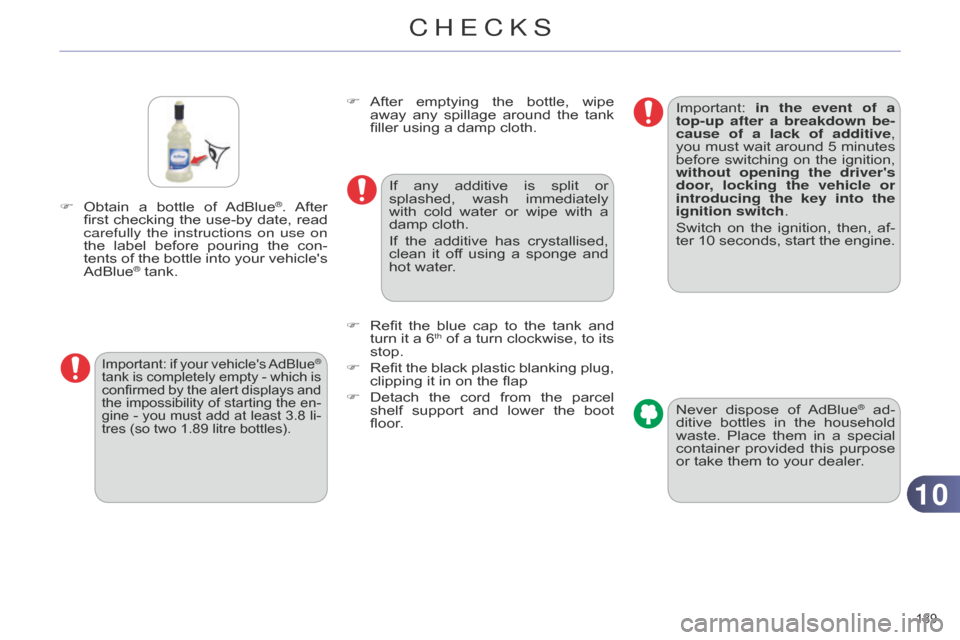
1010
189ô
C4-2_en_Chap10_verification_ed01-2014
Fô Obtainô a ô bottle ô of ô AdBlueôÛ.ô Afterô first
ô checking
ô the
ô use-by
ô date, ô read ô
carefully
the instructions on use on
the
ô
label
ô
before
ô
pouring
ô
the
ô
con
-
tents
ô
of
ô
the
ô
bottle
ô
into
ô
your
ô
vehicle's
ô
AdBlueôÛô tank.
Important:ô if ô your ô vehicle's ô AdBlueôÛ
tank
ô is
ô completely
ô empty
ô -
ô which
ô is
ô
confirmed
ô
by
ô
the
ô
alert
ô
displays
ô
and
ô
the
ô
impossibility
ô
of
ô
starting
ô
the
ô
en
-
gine
ô
-
ô
you
ô
must
ô
add
ô
at
ô
least
ô
3.8ô
li-
tres
ô
(so
ô
two
ô
1.89
ô
litre
ô
bottles).
Fô After ô emptying ô the ô bottle, ô wipe ô away
ô any ô spilla ge ô around ô the ô tank ô
filler
ô using ô a ô damp ô cloth.
If
ô
any
ô
additive
ô
is
ô
split
ô
or
ô
splashed,
ô
wash
ô
immediately
ô
with
ô
cold
ô
water
ô
or
ô
wipe
ô
with
ô
a
ô
damp
ô cloth.
If
ô
the
ô
additive
ô
has
ô
crystallised,
ô
clean
ô
it
ô
of
f ô
using
ô
a
ô
sponge
ô
and
ô
hot
ô water.
F
ô
Refit
ô
the
ô
blue
ô
cap
ô
to
ô
the
ô
tank
ô
and
ô
turn
ô
it
ô
a
ô
6thô ofô a ô turn ô clockwise, ô to ô its ô stop.
F
ô
Refit
ô
the
ô
black
ô
plastic
ô
blanking
ô
plug,
ô
clipping
ô
it
ô
in ô on ô the ô flap
F
ô
Detach
ô
the
ô
cord
ô
from
ô
the
ô
parcel
ô
shelf
ô
support
ô
and
ô
lower
ô
the
ô
boot
ô
floor
. Never
ô
dispose
ô
of
ô
AdBlueôÛô ad-
ditive
ô bottles
ô in
ô the
ô household ô
waste.
ô
Place
ô
them
ô
in
ô
a
ô
special
ô
container
ô
provided
ô
this
ô
purpose
ô
or
ô
take
ô
them
ô
to
ô
your
ô
dealer.
Important:
ô
in the event of a
top-up
after a breakdown be-
cause of a lack of additive,
you
ô
must
ô
wait
ô
around
ô
5
ô
minutes
ô
before
ô
switching
ô
on
ô
the
ô
ignition,
ô
without
opening the driver's
door, locking the vehicle or
introducing the key into the
ignition switch.
Switch
ô
on
ô
the
ô
ignition,
ô
then,
ô
af
-
ter
ô
10
ô
seconds,
ô
start
ô
the
ô
engine.
CHECKS
Page 220 of 340

1111
218ô
C4-2_en_Chap11_info-pratique_ed01-2014
Fô Onô the ô front ô bumper , ô unclip ô the ô coverô by
ô pressing ô at ô the ô bottom.
F
ô
Screw
ô the ô towing ô eye ô in ô fully.
F
ô
Install
ô the ô towing ô bar.
Towing your vehicle
Fô Placeô the ô gear ô lever ô in ô neu -
tral (position N on an elec-
tronic
ô or ô automatic ô gearbox).
Failure to observe this in
-
struction
ô
could
ô
result
ô
in
ô
dam
-
age
ô
to
ô
certain
ô
components
ô
(braking,
ô
transmission...)
ô
and
ô
the
ô
absence
ô
of
ô
braking
ô
as
-
sistance
ô
the
ô
next
ô
time
ô
the
ô
engine
ô is ô started. F
ô
On
ô
the
ô
rear
ô
bumper
, ô
unclip
ô
the
ô
coverô by
ô pressing ô at ô the ô bottom.
F
ô
Screw
ô the ô towing ô eye ô in ô fully.
F
ô
Install
ô the ô towing ô bar.
F
ô
Switch
ô
on
ô
the
ô
hazard
ô
warning
ô
lamps
ô
on
ô both ô vehicles.
F
ô
Move
ô
of
f ô
gently
, ô
drive
ô
slowly
ô
and
ô
for
ô
a
ô short ô distance.
Towing another vehicle
Fô Unlockô the ô steering ô by ô turning ô the ô key
ô in ô the ô ignition ô one ô notch ô and ô re -
lease
ô the ô parking ô brake.
F
ô
Switch
ô
on
ô
the
ô
hazard
ô
warning
ô
lamps
ô
on
ô both ô vehicles.
F
ô
Move
ô
of
f ô
gently
, ô
drive
ô
slowly
ô
and
ô
for
ô
a
ô short ô distance.
PRACTICAL INFORMATION
Page 266 of 340
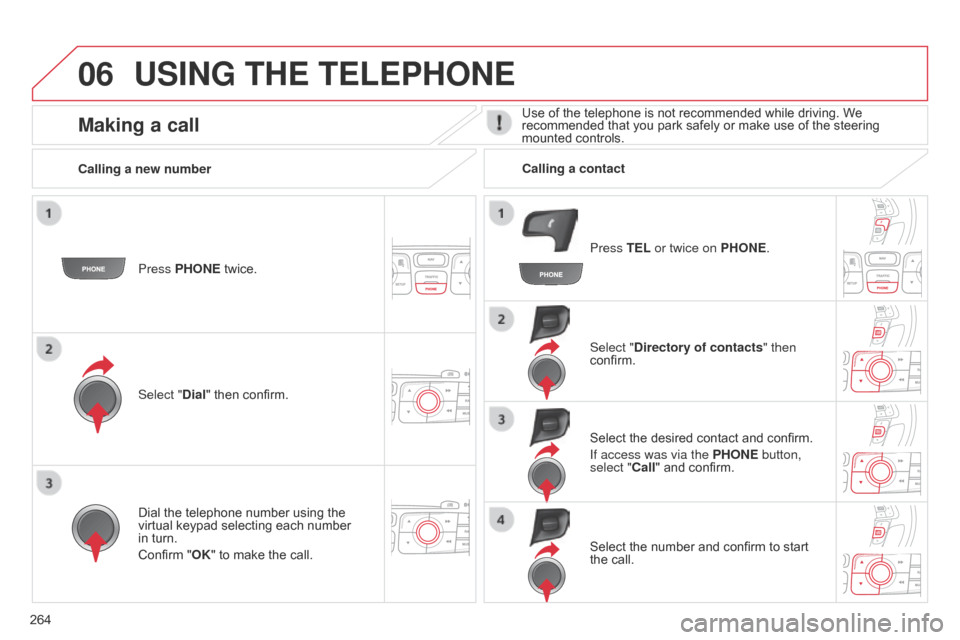
06
264
C4-2_en_Chap13b_RT6_ed01-2014
USING THE TELEPHONE
Press PHONEô twice.
Select " Dial" ô then ô confirm. Select "Directory of contacts" then
confirm.
Dial
ô the ô telephone ô number ô using ô the ô
virtual
ô keypad ô selecting ô each ô number ô
in
ô turn.
Confirm
ô "OK" ô to ô make ô the ô call. Press TEL or twice on PHONE.
Calling a new number
Calling a contact
Select ô the ô desired ô contact ô and ô confirm.
If access was via the PHONE button,
select "Call"
ô and ô confirm.
Select
ô the ô number ô and ô confirm ô to ô start ô
the
ô call.
Making a callUseô ofô theô telephoneô isô notô recommendedô whileô driving.ô Weô recommendedô that ô you ô park ô safely ô or ô make ô use ô of ô the ô steering ô
mounted
ô controls.
Page 269 of 340

06
267
C4-2_en_Chap13b_RT6_ed01-2014
USING THE TELEPHONE
Options during a call*
Duringô aô call,ô pressô theô MODE button
several ô times ô to ô select ô display ô of ô the ô
telephone screen, then press "OK
" to
open
ô the ô contextual ô menu.
Select "Private mode"
ô and ô confirm ô to ô
take
ô the ô call ô on ô the ô handset.
o
r select "Hands-free mode" ô and ô
confirm
ô to ô take ô the ô call ô via ô the ô vehicle's ô
speakers.
Select "
Put call on hold "
ô and ô confirm ô to ô
put
ô the ô current ô call ô on ô hold.
o
r select "Resume the call" ô and ô
confirm
ô to ô resume ô the ô call ô on ô hold. Select "DTMF ring tones
" to use the
numerical ô keypad, ô so ô as ô to ô navigate ô through
ô the ô menu ô of ô an ô interactive ô vocal ô server
.
Select "Hang up"
ô to ô end ô the ô call.
*
ô Depending ô on ô the ô compatibility ô of ô the ô phone ô and ô your ô service ô plan.
it
ô is ô possible ô to ô hold ô a ô 3-way ô conference ô
call
ô by ô making ô 2 ô calls ô in ô succession*. ô
Select "
Conference mode call" in the
contextual
ô menu ô accessible ô using ô this ô
button.
Or
ô make ô a ô short ô press ô on ô this ô button.
Page 273 of 340
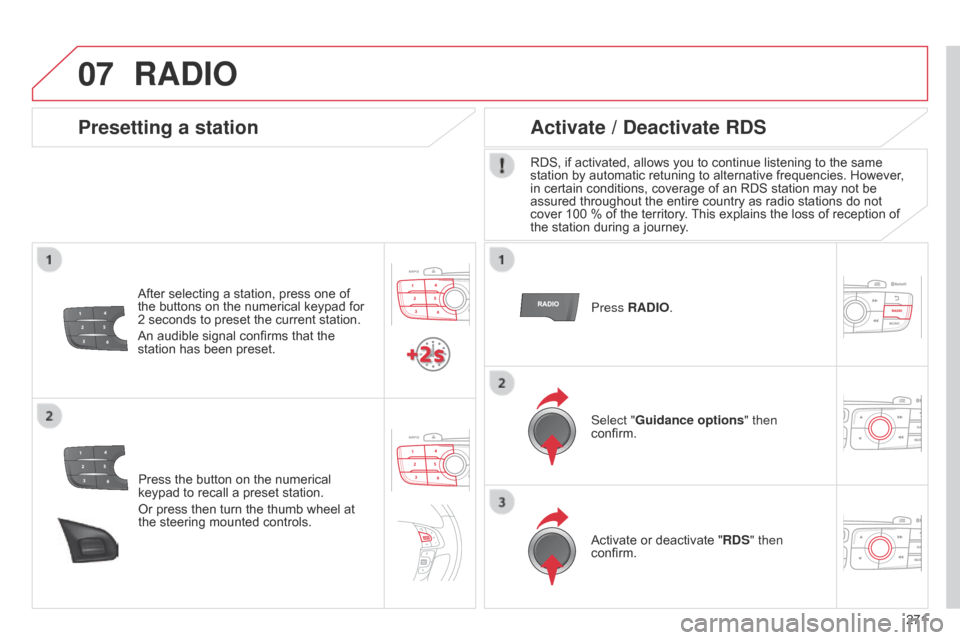
07
271
C4-2_en_Chap13b_RT6_ed01-2014
Pressô theô buttonô onô theô numericalô keypadô to ô recall ô a ô preset ô station.
Or
ô press ô then ô turn ô the ô thumb ô wheel ô at ô
the
ô steering ô mounted ô controls.
Presetting a station
Afterô selectingô aô station,ô pressô oneô ofô theô buttons ô on ô the ô numerical ô keypad ô for ô
2
ô seconds ô to ô preset ô the ô current ô station.
An
ô audible ô signal ô confirms ô that ô the ô
station
ô has ô been ô preset. Press RADIO.
Activate / Deactivate RDS
RDS,ô ifô activated,ô allowsô youô toô continueô listeningô toô theô sameô station
ô by ô automatic ô retuning ô to ô alternative ô frequencies. ô However, ô
in
ô certain ô conditions, ô coverage ô of ô an ô RDS ô station ô may ô not ô be ô
assured
ô throughout ô the ô entire ô country ô as ô radio ô stations ô do ô not ô
cover
ô 100 ô % ô of ô the ô territory. ô
This
ô explains ô the ô loss ô of ô reception ô of ô
the
ô station ô during ô a ô journey.
Select "Guidance options " then
confirm.
Activate
ô or ô deactivate ô "RDS" then
confirm.
RADIO
Page 277 of 340
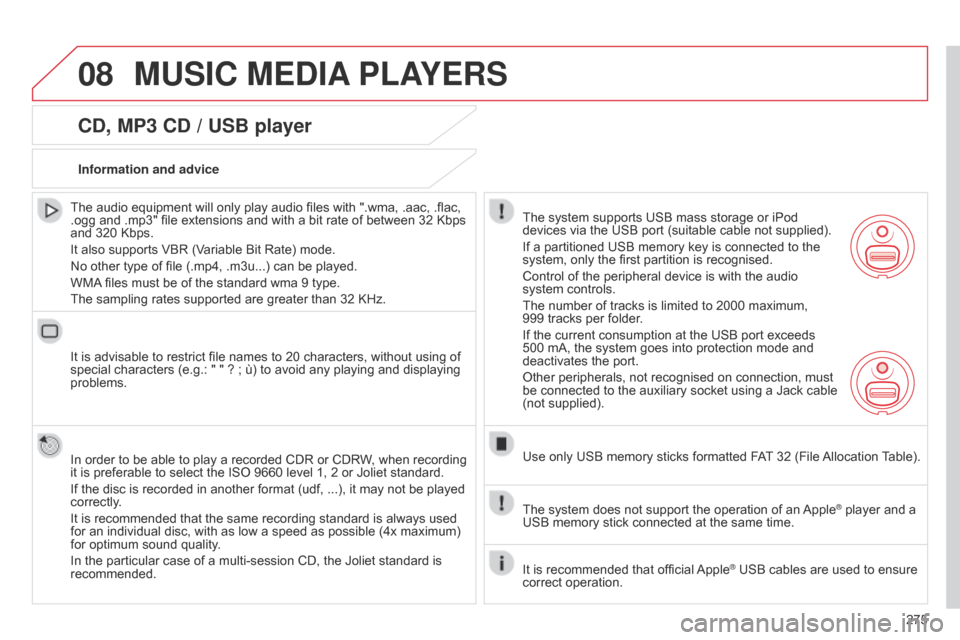
08
275
C4-2_en_Chap13b_RT6_ed01-2014
MUSIC MEDIA PLAYERS
CD, MP3 CD / USB player
Theô audioô equipmentô willô onlyô playô audioô filesô withô ".wma,ô .aac,ô .flac,ô .ogg
ô and ô .mp3" ô file ô extensions ô and ô with ô a ô bit ô rate ô of ô between ô 32 ô Kbps ô
and
ô 320 ô Kbps.
It
ô also ô supports ô VBR ô (Variable ô Bit ô Rate) ô mode.
No
ô other ô type ô of ô file ô (.mp4, ô .m3u...) ô can ô be ô played.
WMA
ô
files ô must ô be ô of ô the ô standard ô wma ô 9 ô type.
The
ô sampling ô rates ô supported ô are ô greater ô than ô 32 ô KHz.
It
ô is ô advisable ô to ô restrict ô file ô names ô to ô 20 ô characters, ô without ô using ô of ô
special
ô characters ô (e.g.: ô " ô " ô ? ô ; ô û¿) ô to ô avoid ô any ô playing ô and ô displaying ô
problems.
In
ô order ô to ô be ô able ô to ô play ô a ô recorded ô CDR ô or ô CDRW, ô when ô recording ô
it
ô is ô preferable ô to ô select ô the ô ISO ô 9660 ô level ô 1, ô 2 ô or ô Joliet ô standard.
If
ô the ô disc ô is ô recorded ô in ô another ô format ô (udf, ô ...), ô it ô may ô not ô be ô played ô
correctly
.
It
ô is ô recommended ô that ô the ô same ô recording ô standard ô is ô always ô used ô
for
ô an ô individual ô disc, ô with ô as ô low ô a ô speed ô as ô possible ô (4x ô maximum) ô
for
ô optimum ô sound ô quality.
In
ô the ô particular ô case ô of ô a ô multi-session ô CD, ô the ô Joliet ô standard ô is ô
recommended.Information and advice
The
ô system ô supports ô USB ô mass ô storage ô or ô iPod ô
devices
ô via ô the ô USB ô port ô (suitable ô cable ô not ô supplied).
If
ô a ô partitioned ô USB ô memory ô key ô is ô connected ô to ô the ô
system,
ô only ô the ô first ô partition ô is ô recognised.
Control
ô of ô the ô peripheral ô device ô is ô with ô the ô audio ô
system
ô controls.
The
ô number ô of ô tracks ô is ô limited ô to ô 2000 ô maximum, ô
999
ô tracks ô per ô folder.
If
ô the ô current ô consumption ô at ô the ô USB ô port ô exceeds ô
500
ô mA, ô the ô system ô goes ô into ô protection ô mode ô and ô
deactivates
ô the ô port.
Other
ô peripherals, ô not ô recognised ô on ô connection, ô must ô
be
ô connected ô to ô the ô auxiliary ô socket ô using ô a ô Jack ô cable ô
(not
ô supplied).
Use
ô only ô USB ô memory ô sticks ô formatted ô FAT
ô
32 ô (File ô
Allocation
ô
T
able).
The
ô system ô does ô not ô support ô the ô operation ô of ô an ô
AppleôÛô playerô andô aô USB
ô
memory
ô
stick
ô
connected
ô
at
ô
the
ô
same
ô
time.
It
ô
is
ô
recommended
ô
that
ô
official
ô
AppleôÛô USBô cablesô areô usedô toô ensureô correct
ô
operation.
Page 312 of 340
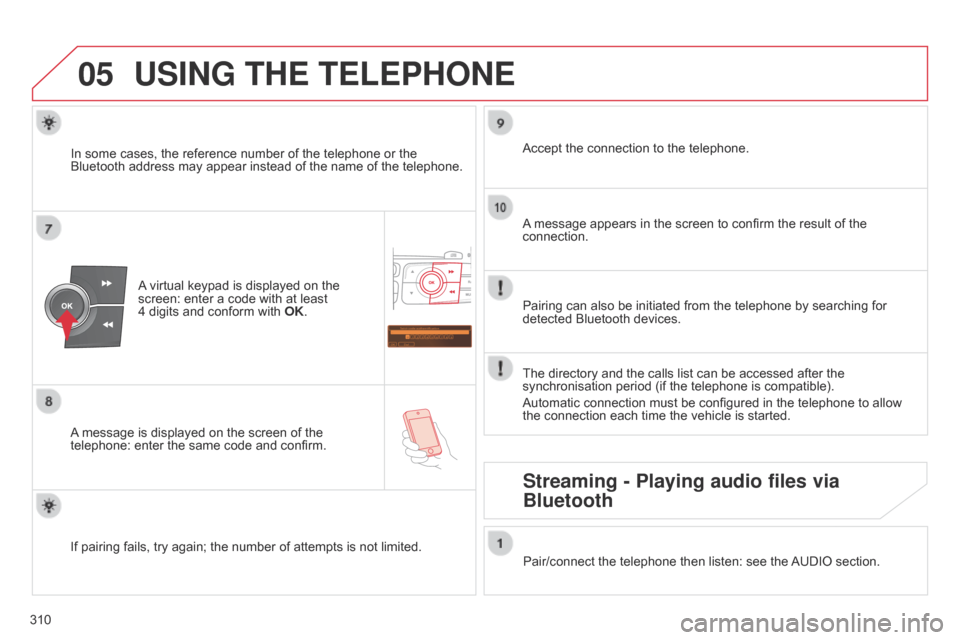
05
Saisir code authentification
01
OK Del 23456789
_
310
C4-2_en_Chap13c_RD5_ed01-2014
USING THE TELEPHONE
Aô virtual ô keypad ô is ô displayed ô on ô the ô screen:
ô enter ô a ô code ô with ô at ô least ô
4ô digits
ô and ô conform ô with ô
OK
.
A
ô
message
ô
is ô displayed ô on ô the ô screen ô of ô the ô
telephone:
ô
enter ô the ô same ô code ô and ô confirm. A
ô
message ô appears ô in ô the ô screen ô to ô confirm ô the ô result ô of ô the ô
connection.
Pairing
ô can ô also ô be ô initiated ô from ô the ô telephone ô by ô searching ô for ô
detected
ô Bluetooth ô devices.
Accept
ô the ô connection ô to ô the ô telephone.
If
ô
pairing
ô
fails, ô try ô again; ô the ô number ô of ô attempts ô is ô not ô limited.The
ô directory ô and ô the ô calls ô list ô can ô be ô accessed ô after ô the ô
synchronisation
ô period ô (if ô the ô telephone ô is ô compatible).
Automatic
ô connection ô must ô be ô configured ô in ô the ô telephone ô to ô allow ô
the
ô connection ô each ô time ô the ô vehicle ô is ô started.
In
ô
some
ô
cases, ô the ô reference ô number ô of ô the ô telephone ô or ô the ô
Bluetooth
ô
address ô may ô appear ô instead ô of ô the ô name ô of ô the ô telephone.
Pair/connect ô the ô telephone ô then ô listen: ô see ô the ô
AUDIO
ô section.
Streaming - Playing audio files via
Bluetooth